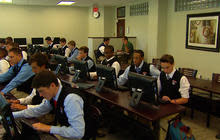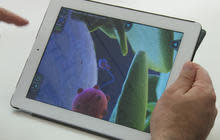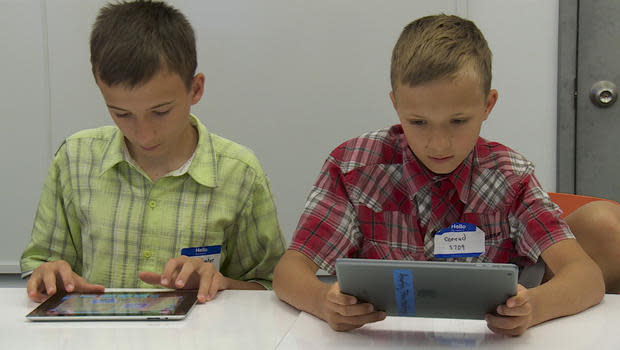Digital learning takes front row seat in classrooms
WHITE PLAINS, NEW YORK -- Familiar scenes come to mind as kids around the country go back to school: yellow buses making pick ups, hallways crowded and noisy, and students lugging backpacks full of heavy textbooks to class.
That won't be the case at Archbishop Stepinac High School, at least on the last note, where students are starting their second year of using an all-digital textbook library. Stepinac, located in the New York City suburb of White Plains, has been touted as the first school in the U.S. to adopt a digital textbook library, which provides students with access to all of its textbooks online.
"Students are able to access any grade level of any textbook that we offer," said Patricia Murphy, director of technology at the all-boys private school. "If they're in 11th grade and they need a brush up on quadratic equations, they can go back to their 9th grade textbook."
Murphy was part of a small group of teachers and administrators at Stepinac that brought the idea of the library to their partners at education publishing house Pearson more than three years ago.
Together, the team created a way for students to access digital versions of all their textbooks on computers and tablets. There are around 40 textbooks available in the digital library.

Archbishop Stepinac High School WCBS
"In the social studies books, there are actual speeches so the student doesn't have to hear the teacher dryly repeat any famous speech," said Murphy. "They can actually watch Dr. Martin Luther King's 'I Have A Dream' speech. It's much more engaging when you hear it from him, as opposed to hearing all these abstract ideas."
Each student pays $150 for one year of access to the digital textbook library for core subjects, with additional fees of about $15 for each textbook for elective courses. Since traditional textbooks can cost between $80 and $200 each, students can save hundreds of dollars with the digital versions. While Murphy could not say how much each individual student spends on laptops or tablets, she said the options available range from a $179 tablet to a $1,500 laptop.
Murphy also said that the school provides technical support for any device that best fits a family's needs.
Joe Desanctis, a senior, was skeptical about losing the touch and feel of traditional textbooks but said he now prefers the digital versions, which update with new information and annual revisions automatically.
"Not only is it literal stress off my back because of my backpack," he said, "but it's just way easier to have it all on your computer screen."
The consolidation of reference books, digital assets like videos, virtual lectures and notes creates a sense of convenience that is shared by his classmates.
"I like the fact that it's all there," said James Mitchell, a junior. "I don't have to go through textbook to textbook, leaving one at school, leaving one at home, switching from my locker and whatnot, carrying a giant backpack full of books."
But beyond convenience, the school saw some academic improvement since switching to the digital textbook library. Based on the limited sample - just one year - Stepinac found that the percentage of students with failing grades was cut in half.
"I actually feel like I'm learning more with it," Mitchell said. "I'm actually understanding. My grades can definitely prove that."
The shift to digital by schools has caught the attention of companies like Amplify, a education technology company based in Brooklyn, New York.
After four years of development and testing, Amplify is now rolling out its all-digital curriculum to between 40 and 50 public middle schools around the country.
It also sells a tablet, pre-loaded with lessons and educational games, that students and teachers can use in classrooms and at home. Larry Berger, the president of Amplify Learning, says that while the content stays true to the "age-old goals of education," Amplify creates a more engaging classroom environment catered to the needs of a modern student.

CBS
"There is a new digital world where kids have to become digital citizens," Berger said. "They have to be able to use social tools to learn. They have to be able to interact with content in ways that really are different than 20 years ago."
Amplify's curriculum includes assignments for students to build visual scenes of story-lines, watch dramatic readings of a text by actors and travel through a human cell.
"This has been an unusual collaboration of not just educators and editors who make curriculum materials but also real leading experts in every walk of life," Berger said. "A lot of times those kinds of people are left out of helping make school exciting."
The curriculum currently costs $45 per student per year, including access to an electronic library of more than 300 books, both fiction and nonfiction.
Amplify's tablet system, which includes the hardware, curriculum and support, costs $359.
Amplify's program also offers analytics tools to teachers that use its curriculum. Based on a student's performance in exercises and games, a teacher can offer extra help to a student in need. This kind of personalization -- also an upshot of Stepinac's digital textbook library -- is one of the main promises of using technology in schools.
"We know that students learn differently, and we need to reach them where they are today," said Ulrich Boser, a senior fellow at the Center for American Progress based in Washington, D.C. "We know that these technologies today are far more interactive, far more richer, so they allow students to really engage deeply with ideas."
Boser, who authored of a study about how American students use technology in schools, sees the use of tablets and similar devices in classrooms as inevitable, as access to the Internet and the machines themselves becomes commonplace. But the success of technology in schools to boost achievement has so far been mixed.
There have been problems with implementation -- one school district in North Carolina is restarting distribution of more than 19,000 Amplify tablets after suspending the program last year due to safety concerns -- and Boser's research found that many schools use technology for simple "drill and practice," instead of more hands-on, immersive activities. Boser also questions whether electronic devices are appropriate for all subjects. Reading, for example, requires deep focus.
"Learning to read is such a key practice for students," Boser said. "We need to make sure that technology doesn't distract them but really helps them."

Two middle schoolers test Amplify math game CBS
The effectiveness of digital tools relies partly on the teachers that are employing them, according to Boser. Back at Stepinac, Murphy said one of the school's goals this year is to encourage all of its teachers to better integrate the media in the digital textbook library into lesson plans.
"It was hard for [teachers] to get used to the fact that they didn't have to stand at the front of the room," she said. "They didn't have to just be attached to the board and the lecture podium. Now there's going to be more circulation, more group work, more apprenticeship learning."
Murphy calls it "flipping" the classroom: students can learn the basics of a subject at home, using their digital textbook and the accompanying media. During class time, teachers can work one-on-one with students on assignments and experimentation.
Additional upgrades to Stepinac's program this year include 40 new charging stations and 10 additional "loaner" tablets for students who forget devices at home or find them unusable once at school. Over the last two years, Stepinac has invested $1 million in infrastructure to support its digital library, like increasing the number of WiFi hotspots in the school.
Not all schools in the U.S. will be able to replicate the success of Stepinac this year, but there is a consensus that the possibility -- and the potential -- of digital learning is already here.
"When we think about technology in schools today, I think we've moved past access," Boser said. "The question now is use. How are students using computers? Are they doing it in new ways?"
It's a question that educators at Stepinac and Amplify, along with others around the world, are taking steps to answer.

